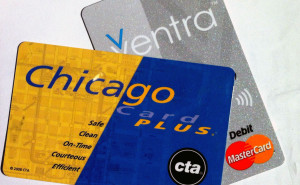 Chicago’s transit system has had a few farecard systems: over the past decade, a magnetic stripe system has coexisted with the Chicago Card (and Chicago Card Plus) contactless smart card system, an RFID system for electronically paying for bus and train fares. The Chicago Card system is actually quite a decent design, where a rider can tap the card against a touchpad on a bus or turnstile, and set it up to automatically reload itself at set low balances.
Chicago’s transit system has had a few farecard systems: over the past decade, a magnetic stripe system has coexisted with the Chicago Card (and Chicago Card Plus) contactless smart card system, an RFID system for electronically paying for bus and train fares. The Chicago Card system is actually quite a decent design, where a rider can tap the card against a touchpad on a bus or turnstile, and set it up to automatically reload itself at set low balances.
This is being replaced by Ventra, which is also an RFID card, but with several important additional features designed by the criminally insane. First, you’ll notice the debit Mastercard logo which appears on the Ventra card — this has two important implications. The first is that instead of using a Ventra card at all, you can instead pay for your ride with any regular debit or credit card with an RFID chip, right? That’s got to be handy.
Well, sort of. Since most regular debit or credit cards won’t record, or more importantly, notify a turnstile about a transfer you just took, you’ll be paying full fare for any bus-to-train or train-to-bus or any other permutations of transfers for which you’d normally be entitled to a discount. So consider yourself screwed there.
In addition, one of the popular uses of RFID technologies is to leave the devices in one’s wallet/purse/etc and wave it at the reader. This is, shall we say, a really bad idea if every card in your wallet is going to pay for your train ride every time you walk through a turnstile. Since a Ventra card is doing what an RFID Mastercard would be doing plus exchanging data about transfers, it’s actually a bit slower — perceptably so, if I may judge from the number of people giving themselves the Heimlich on the turnstiles while attempting to use their Ventra card.
On to the second implication of that Debit MasterCard logo: the Ventra card can also be used as a debit MasterCard — not that the same debit balance used to pay for the train might also be used to buy a sandwich, or even that you can link the card somehow to your own bank account, but that you can set up a new, separate, prepaid debit account, because apparently you’re a raving lunatic who would rather spend hundreds of dollars on fees than carry around two cards, one for riding the train, and another one for buying sandwiches. If you truly can only lift one card and have no need of extra money, you’re probably still better off with just a regular credit card.
In August, I got an email that I’m being transitioned from my working Chicago Card Plus to Ventra, along with a note that the balance from my Chicago Card would be moved to my Ventra card “as soon as” my Ventra card was activated. In September, I received a Ventra card, with a letter referring to an email that supposedly had an access code that I’d need to activate it.
If I were a sociopath designing a card activation, I don’t think I could do better than online activation that makes you type in a lot of information in order to ultimately direct you to a help line, where the help line makes you type in your card number and other identifying information, places you on hold for a while, before announcing that the lines are all busy and maybe you should try activating online.
Over the course of several days, I took a spin through this circle of sadistic incompetence, but was rescued when I finally did get an activation email. Well, rescued from the phone, anyway — it turns out the psychotic web designers spent a lot of time making a fairly pretty graphic of a spinning thing for you to look at for ten minutes before the web site tells you there’s some kind of error, and it can’t make the mandatory changes it requires you to make before allowing you to continue.
So the “immediate” balance transfer from my Chicago Card has been at least two weeks, and despite my customer service inquiry to the sociopaths at Ventra, there has been no response. Not that I’m in any kind of hurry.

